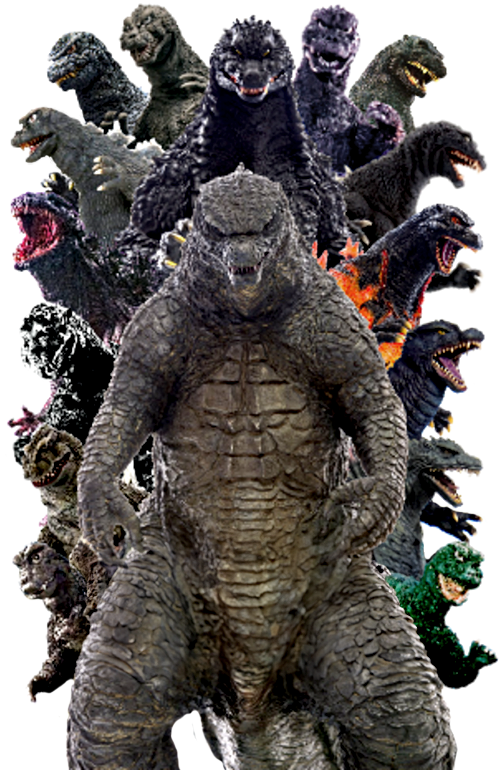
Godzilla Designs by Year
G-Fan
Excerpt from Issue #16 / July-August 1995
During the King of the Monster’s 70 year history, a new Godzilla costume would need to be built for each of the early movies, or the most recent suit would be repaired and/or modified. It became a tradition at Toho that each Godzilla costume would have its own distinctive look. As Godzilla’s personality changed over the years, so did his physical appearance. For scenes that required water shots or extreme wear on the suit (such as pyrotechnics and fighting), the SPFX crew would usually employ an older, expendable Godzilla suit. Toho was also not reluctant to cut up their finely crafted Godzilla costumes for brief scenes. In the earlier films tight shots of small puppets, controlled either manually or electronically, were inter cut with shots of the actor in the Godzilla suit. An electronically controlled upper body with flexible facial expressions has been employed in the 90’s films. However, these articles will deal only with Godzilla suits, as well as any “stunt” suits and “half-suits” that appeared in certain scenes.
The technical aspects of Godzilla suit construction will not be covered other than to say that prior to 1984, Godzilla suits were built using a “scratch-building” technique, i.e., no molds were employed. The costumes were created by constructing a stuffed body suit covered with a latex skin to which Godzilla’s distinctive skin texture would be added. From 1984 onward, molds were employed; various parts of the Godzilla suit were cast separately in latex and then assembled. The same body molds (85-95 or Heisei) have been used for all Godzilla suits since Godzilla 1985, and the same head mold since Godzilla vs Biollante. The differences in the newer costumes are due to the assembly process as well as the amount and shape of reinforcement in the suit.
The practice of giving each of the various Godzilla costumes a nickname is fairly new, with the exceptions of “Kingoji” and “Mosugoji ” which originated in the 1980s. The use of nicknames apparently started with garage kit companies and was adopted in recent Godzilla digests. These nicknames are either a combination of part of the films’ title, such as Daisenso-Godzilla for the costume from Kaiju Daisenso (Monster Zero), or by combining the first two syllables of “Gojira” with the first two syllables of Godzilla’s opponent in a particular film, such as Kingoji for the costume from King Kong tai Godzilla (King Kong vs Godzilla).
Although this article does not use a rating system to assess the aesthetic appeal of each Godzilla suit, it is noted which Godzilla suits are considered popular and not-so-popular. These comments are based on the annual fan polls, by observing which Godzilla styles are the most represented in the Japanese model kit market, and also on opinions expressed to the author by fellow writers and enthusiasts.


Links
Contact
Have you already completed your own Godzilla costume and want to feature it here? Then by all means contact me and we’ll work together to add your costuming experience to this site.
